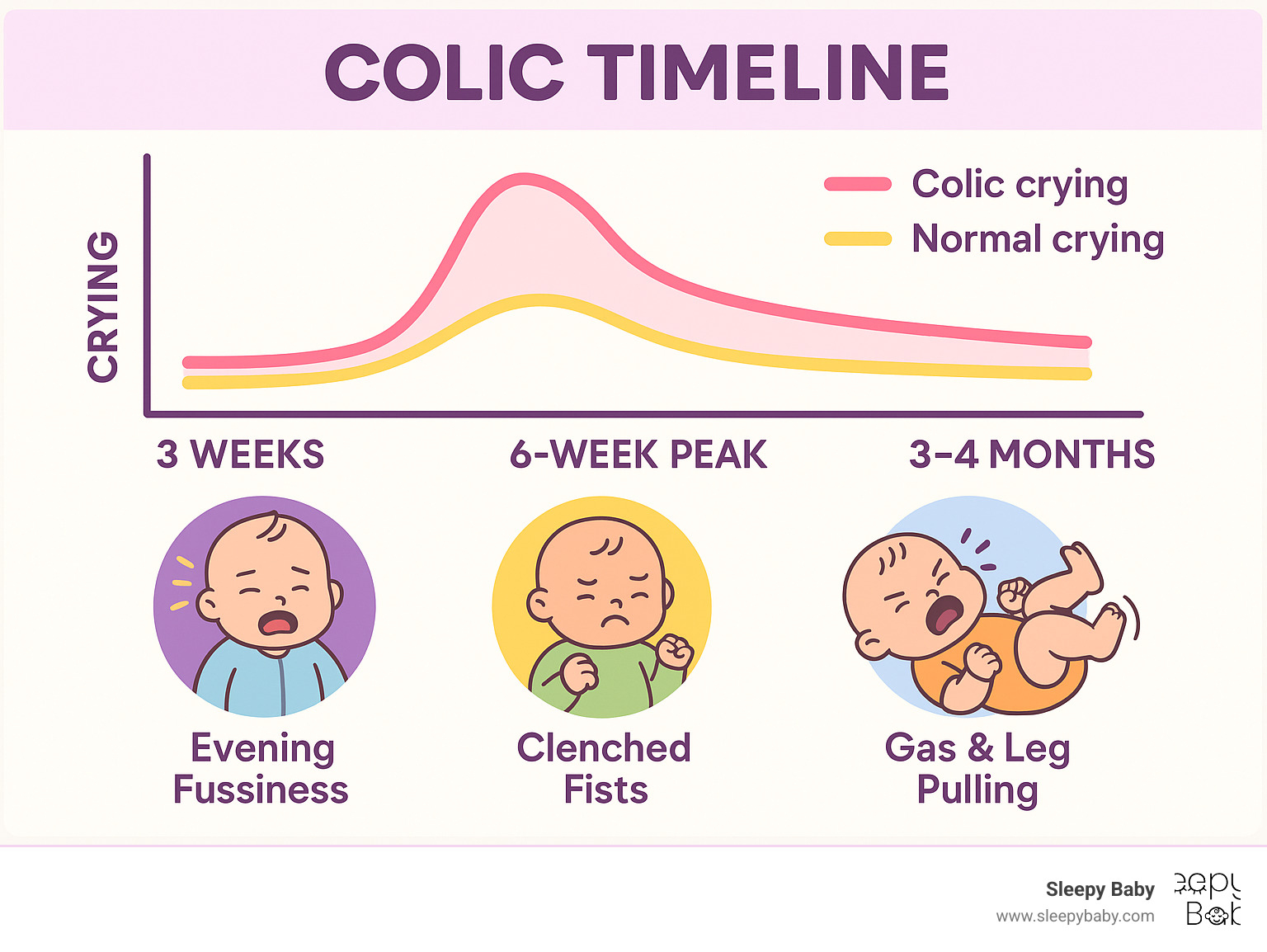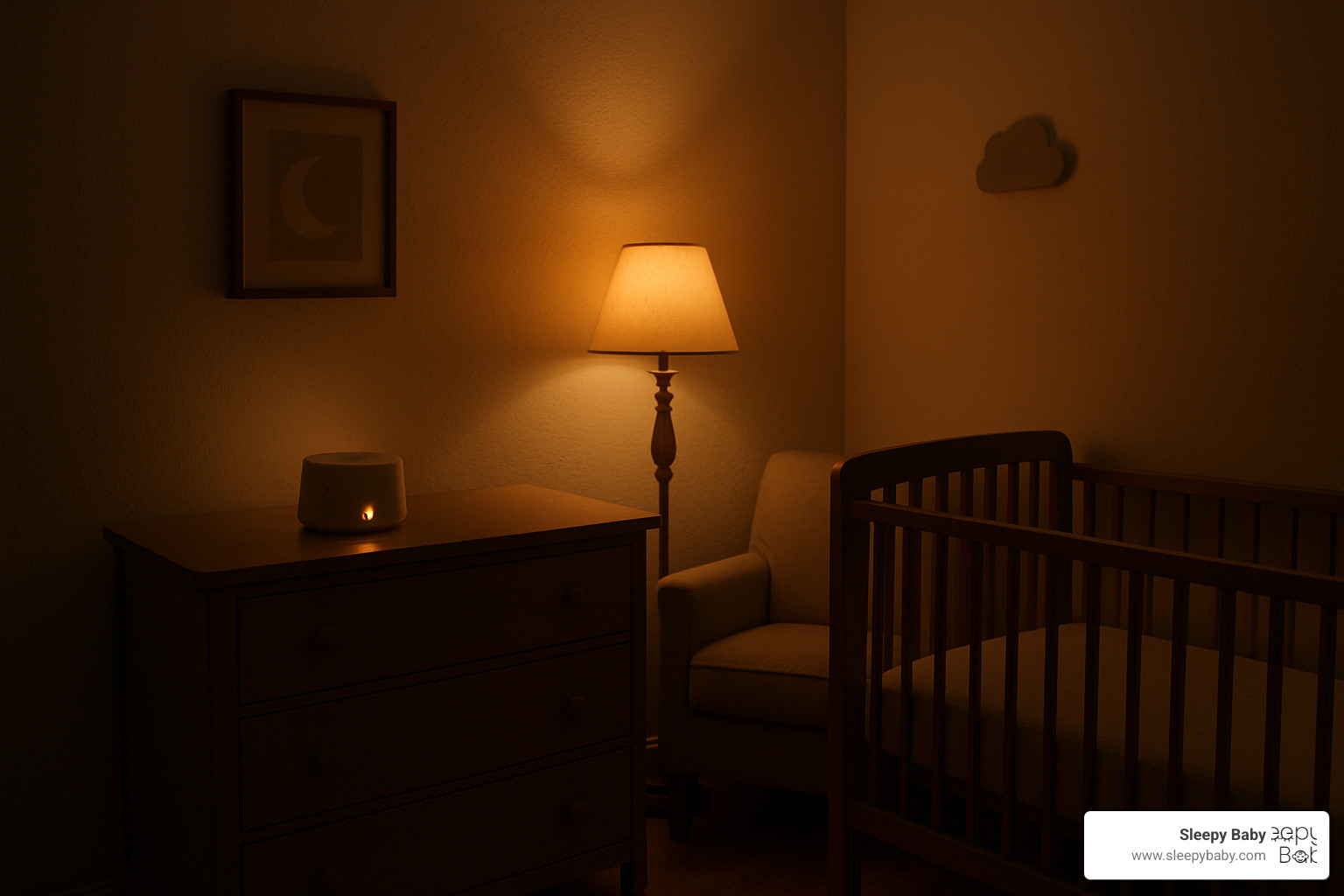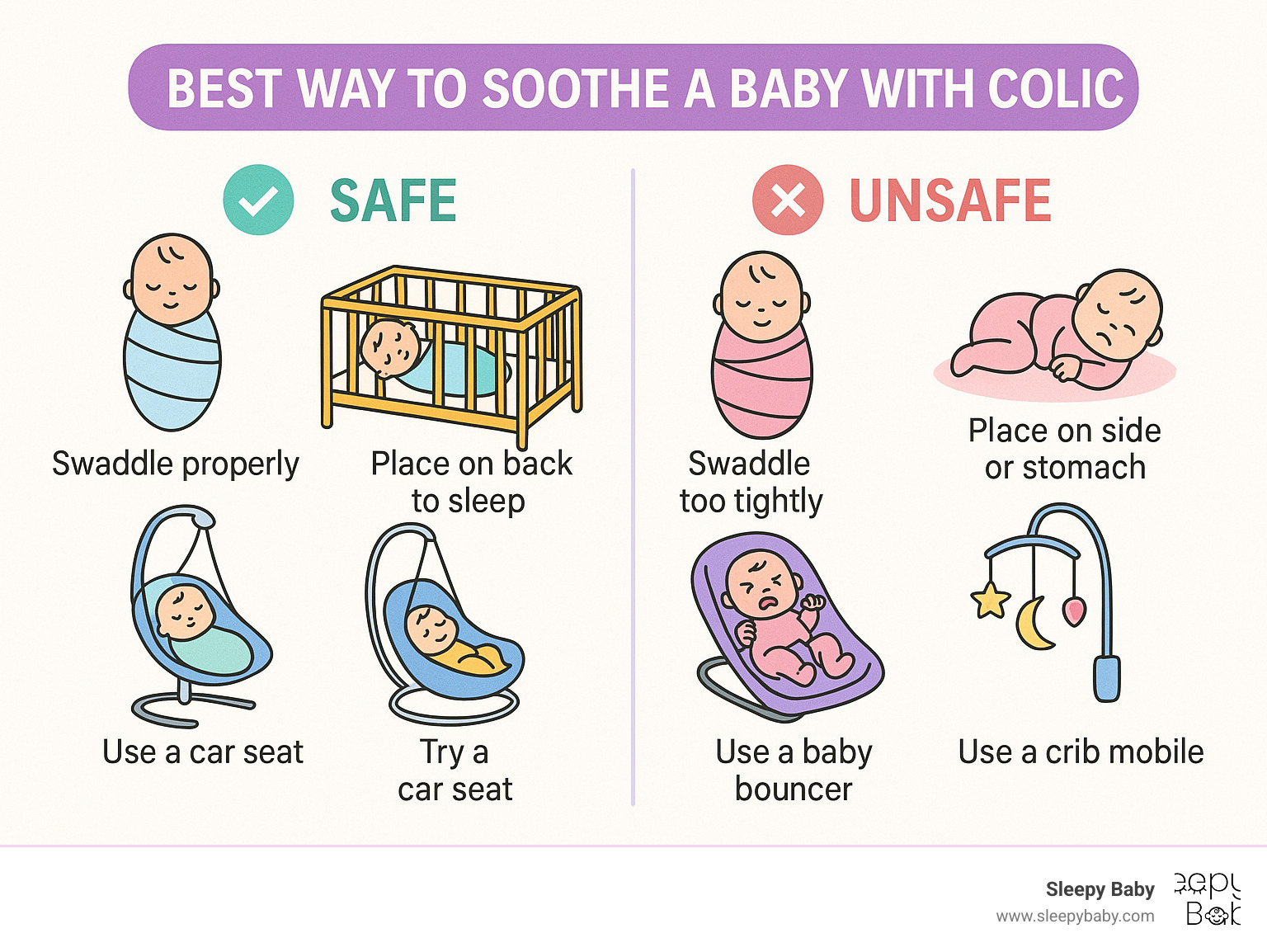Understanding Colic: When Your Baby's Crying Feels Endless
The best way to soothe a baby with colic involves a combination of proven techniques that address your baby's discomfort while protecting your own mental health. If your otherwise healthy baby cries for more than 3 hours a day, at least 3 days a week, for more than 3 weeks, you're likely dealing with colic.
Quick Solutions for Colicky Babies:
- Swaddle tightly and hold baby on their side or stomach (never sleep this way)
- Create white noise with fans, vacuum cleaners, or sound machines
- Try rhythmic motion through rocking, walking, or car rides
- Apply gentle tummy pressure with the "football hold" or warm compress
- Offer a pacifier to satisfy sucking reflex
- Take breaks - place baby safely in crib when overwhelmed
You're not alone in this struggle. About 1 in 5 babies develop colic, typically starting around 3 weeks of age and peaking at 6 weeks. The good news? Most babies outgrow colic by 3-4 months old.
Those evening crying sessions between 6 PM and midnight aren't your fault. Colic often reflects an immature nervous system rather than poor parenting. Your baby is still healthy and growing normally - they just need extra help learning to self-soothe.
I'm Gary Harutyunyan, and my own experience with a colicky newborn led me to research and develop solutions for the best way to soothe a baby with colic when traditional methods weren't enough. After trying countless techniques and products, I created the Sleepy Baby patting device to help families like ours find the rest we desperately needed.

Colic 101: Signs, Timeline & When to Call the Doctor
Every parent knows the difference between a hungry cry and a tired cry, but colic? That's a whole different beast. When your baby launches into those intense, inconsolable crying sessions that seem to come from nowhere, you're probably witnessing colic in action.
The 3-3-3 rule helps us identify colic: crying for more than 3 hours a day, at least 3 days a week, for more than 3 weeks. But beyond the numbers, colic has its own signature. Your baby's cry will sound different - more urgent and desperate than their usual complaints about wet diapers or empty bellies.
During these episodes, you'll notice your little one's clenched fists and tensed body, almost like they're bracing against invisible pain. Their face turns red and flushed, and they'll often pull their legs up toward their belly or extend them rigidly. The gas that accompanies these sessions can be impressive - and frequent.
Most colicky babies save their dramatic performances for late afternoon or evening, right when you're already exhausted from the day. It's like they have an internal timer set for maximum parental stress.
The timeline offers hope for weary parents. Colic typically begins around 3 weeks of age, reaches its peak intensity at 6 weeks, and gradually resolves by 3-4 months. Some babies stretch this timeline to 6 months, but that's less common. Scientific research on colic definition confirms that about 20% of infants experience colic, and it's not caused by anything you did wrong.
The best way to soothe a baby with colic often involves understanding that their immature digestive system, heightened sensitivity, or gut bacteria imbalance is driving these episodes. It's biological, not behavioral.
Spotting the Red Flags vs. Typical Colic
While colic tests every parent's patience, it's crucial to recognize when crying signals something more serious. Your parental instincts matter here - if something feels off, trust that feeling and contact your pediatrician.
Fever in babies under 2 months is always a red flag, as is persistent vomiting that goes beyond normal spit-up. Watch for bloody or black stools, failure to gain weight, or poor feeding patterns. If your baby's cry becomes high-pitched, weak, or unusually different, or if you notice difficulty breathing during episodes, seek immediate medical attention.
Signs of dehydration like fewer wet diapers or a sunken soft spot on their head also warrant a doctor's visit. Sometimes the crying itself isn't the concern - it's these accompanying symptoms that signal trouble.
You should call your pediatrician when colic symptoms persist beyond 4 months, or if you suspect your baby might have gastroesophageal reflux or food allergies instead of straightforward colic. These conditions can mimic colic but require different treatment approaches.
Don't hesitate to reach out for support when you're feeling overwhelmed. The Cry-sis helpline (1-866-243-2229) provides 24/7 support for parents struggling with excessive infant crying. Sometimes just talking to someone who understands can make all the difference in finding the strength to keep going.
The Best Way to Soothe a Baby with Colic: 10 Tried-and-True Methods
When your baby is screaming and nothing seems to help, you'll try anything. I've been there - pacing the hallway at 2 AM, wondering if the crying will ever stop. After years of research and countless conversations with exhausted parents, I've learned that the best way to soothe a baby with colic isn't just one magic trick. It's about having a toolkit of proven techniques and finding the right combination for your little one.

The secret lies in recreating the womb environment your baby knew for nine months. Think about it - they went from a warm, snug space with constant motion and rhythmic sounds to our bright, quiet world. No wonder they're overwhelmed.
Swaddling creates that familiar snugness. Wrap your baby firmly in a large, thin blanket, keeping their arms secure but allowing hip movement. Always place swaddled babies on their backs to sleep. Some parents worry about swaddling too tightly, but most babies need that secure feeling to calm down.
The side or stomach position works wonders when your baby is awake and fussy. Hold them on their left side or gently across your lap, stomach down. This position helps trapped gas move through their system while applying gentle pressure to their belly. Never let them sleep this way - it's only for soothing while you're holding them.
Rhythmic motion mimics the constant movement they felt in utero. Rock, sway, or gently bounce at about 60-70 beats per minute - the same rhythm as your heartbeat and blood flow. Your baby spent months listening to and feeling this rhythm, so it's deeply comforting.
White noise recreates the whooshing sounds of the womb. Try running a fan, dishwasher, or vacuum cleaner. The sound should be loud enough for baby to hear over their crying but not so loud it hurts their ears. Consistency is key - sudden silence can actually startle them awake.
A pacifier satisfies their natural sucking reflex, which is incredibly soothing for most babies. Even if you're breastfeeding, offering a pacifier during fussy periods won't cause confusion once nursing is established. Recent studies suggest pacifiers may even reduce SIDS risk.
Warm baths work especially well when combined with gentle massage. The warm water relaxes tense muscles while the skin-to-skin contact provides comfort. Some babies love water from day one, while others need time to adjust.
Infant massage helps move trapped gas and provides calming touch. Use slow, firm strokes on your baby's tummy in clockwise circles. Try the "bicycle legs" technique - gently moving their legs like they're pedaling a bike. This helps gas bubbles work their way out.
Tummy pressure through the "football hold" can provide immediate relief. Support your baby's head and neck on your forearm while their belly rests against your arm. This position applies gentle pressure to their abdomen while keeping them secure.
Frequent burping prevents gas buildup that contributes to colic pain. Try burping during and after feeds using different positions - over your shoulder, sitting upright on your lap, or face-down across your legs. Some babies need more burping than others.
When all else fails, car rides or stroller walks often work like magic. The combination of motion, vibration, and white noise from the engine hits multiple soothing triggers at once. I can't count how many parents have driven around the block at midnight just to get their baby to sleep.
Swaddle & Side-Stomach Carry: The Best Way to Soothe a Baby with Colic on the Go
The combination of tight swaddling and the "colic carry" position is often our most powerful immediate intervention. When your baby is melting down in public or you need quick relief, this technique can work within minutes.
Start with a proper swaddle - wrap your baby snugly enough that they can't wiggle their arms free, but keep the hip area loose for healthy development. Then transition to the "colic carry" or "football hold." Support their head and neck along your forearm while their belly rests against your arm. This applies gentle pressure to their abdomen while recreating that secure, contained feeling they crave.
Add a gentle rocking motion, and you've hit the trifecta - pressure, security, and rhythmic movement. Many parents find this position works when nothing else does, especially during those dreaded evening fussy periods.
For deeper techniques that combine traditional methods with modern understanding of infant development, explore our Natural Harmony techniques guide.
Rhythmic White Noise: Another Best Way to Soothe a Baby with Colic at Night
White noise isn't just background sound - it's a powerful tool that taps into your baby's deepest memories of comfort and safety. For nine months, they lived surrounded by the constant whooshing of blood flow, muffled voices, and digestive sounds. Our quiet homes can feel eerily silent by comparison.
The key is finding the right type and volume of white noise. Household fans are often the most effective and safest option - they provide consistent sound without the risk of overheating or electrical issues. The gentle hum mimics womb sounds perfectly.
Running appliances like dishwashers or washing machines work well too, though you can't control when they're available. Some desperate parents have been known to run the vacuum cleaner or hair dryer, but use these cautiously and never leave them unattended.
White noise machines or smartphone apps offer convenience and control, but make sure the volume is appropriate. The sound should be loud enough for your baby to hear over their own crying - about as loud as a running shower - but not so loud it could damage their developing hearing.
Scientific research from Children's Hospital of Philadelphia confirms that consistent background noise can significantly reduce crying episodes when used as part of a regular soothing routine. The key word is consistent - sudden changes in sound level can actually wake or startle your baby.
Every baby is different. What works for your friend's baby might not work for yours, and that's completely normal. Keep trying different combinations until you find your baby's unique comfort formula.
Feeding Strategies & Tummy Relief
When your baby's tummy is upset, every feeding can feel like a battle. The good news? Small changes to how and what you feed your little one can often make a big difference in their comfort level.
Feeding position is everything when you're looking for the best way to soothe a baby with colic. Hold your baby upright during feeds to help reduce the amount of air they swallow. This simple change can prevent those painful gas bubbles that contribute to colicky crying.
If you're bottle feeding, try paced feeding - let your baby control the flow instead of rushing through meals. Think of it like sipping a milkshake through a straw versus chugging it. Your baby's digestive system will thank you for the gentler approach.
Smaller, more frequent meals work better than large feeds spaced far apart. Instead of feeding every 3-4 hours, try every 2-2.5 hours with smaller amounts. This gives your baby's immature digestive system an easier workload.
Keep your baby upright for 15-20 minutes after feeding. I know this sounds impossible when you're exhausted, but even a few minutes can help prevent that milk from coming back up.
For breastfeeding mothers, you might wonder if something you're eating is bothering your baby. While less than 5% of colic cases are actually caused by food sensitivities, you can try eliminating common culprits like dairy, caffeine, chocolate, or spicy foods one at a time for two weeks each. Don't feel pressured to drastically restrict your diet without seeing clear results - you need proper nutrition too.
Formula-fed babies sometimes benefit from protein hydrolysate formulas or those designed to reduce gas. Bottles with special venting systems can also minimize air intake. Talk with your pediatrician before switching formulas, as frequent changes can sometimes make things worse.
Gas relief options include simethicone drops, though the evidence for their effectiveness is limited. Some studies suggest that Lactobacillus reuteri probiotics might help reduce crying time, but results vary between babies.
Try gentle burping techniques in different positions - over your shoulder, sitting upright on your lap, or face-down across your knees. The "bicycle legs" exercise, where you gently move your baby's legs in a cycling motion, can help move trapped gas through their system.
| Formula Type | Gas Relief Benefit | Best For |
|---|---|---|
| Standard | Basic nutrition | Most babies |
| Anti-colic/Gas-reducing | Reduced air bubbles | Gassy babies |
| Protein hydrolysate | Easier digestion | Sensitive stomachs |
| Lactose-free | Eliminates lactose | Lactose intolerance |
For detailed information about what actually works versus marketing hype, check out our guide on Colic Drops: separating fact from fiction.
What works for one baby might not work for another. Be patient with yourself as you figure out your baby's unique needs.
Creating a Calming Environment: Sound, Motion & Light Hacks
Your baby's environment can make or break your colic-soothing efforts. Think of it this way - if you were feeling overwhelmed and cranky, would bright lights and sudden noises help you calm down? Probably not. Colicky babies are often dealing with sensory overload, and the best way to soothe a baby with colic often starts with creating a womb-like sanctuary.

Dimming the lights during those dreaded evening fussy periods can work wonders. Bright overhead lights feel harsh when your baby is already overstimulated. Instead, use soft lamplight or even just the glow from a hallway. Your baby spent nine months in darkness, so recreating that cozy, dim environment helps signal that it's time to wind down.
Temperature matters more than you might think. Keep your nursery at a comfortable womb-like temperature - around 68-70°F. Too hot and your baby becomes fussier; too cold and they'll tense up instead of relaxing. A good rule of thumb: if you're comfortable in a light shirt, your baby is probably at the right temperature when properly dressed.
The magic really happens when you combine gentle white noise with rhythmic motion. That steady hum from a fan isn't just background noise - it's recreating the constant whooshing sound your baby heard from your blood flow and heartbeat for months. Position a fan safely in the room (never pointed directly at baby) for consistent, natural white noise that also helps with air circulation.
When it comes to motion, think gentle and rhythmic rather than vigorous. A slow stroller walk around the block, a peaceful car ride (when you're alert and safe to drive), or simply swaying while holding your baby can provide the movement they crave. Some parents swear by vibrating infant seats for short periods, though nothing beats the comfort of being held and gently rocked by a loving caregiver.
Baby slings and carriers are lifesavers for parents dealing with colic. Your baby gets the motion, warmth, and closeness they need while your hands stay free. Plus, the upright position can help with gas and digestion issues that often contribute to colic discomfort.

Creating a consistent evening routine starting about 30 minutes before your baby's usual fussy time can help prevent some meltdowns before they start. This might include dimming lights throughout the house, starting gentle background noise, and avoiding overstimulating activities like loud music or bright screens.
Overstimulation avoidance is key. That means limiting visitors during peak fussy times, keeping decorations in the nursery simple and calming, and avoiding sudden changes in environment when your baby is already on edge. Sometimes the most loving thing you can do is create a boring, predictable space where your little one can finally relax.
The goal isn't to eliminate all stimulation - it's about finding that sweet spot where your baby feels secure and calm without becoming overwhelmed. Every baby responds differently, so don't get discouraged if it takes some trial and error to find your perfect combination of sound, motion, and lighting.
Frequently Asked Questions about Colic & Soothing
How long will colic last and will my baby outgrow it?
Here's the reassuring truth every exhausted parent needs to hear: your baby will outgrow colic. Most babies find relief by 3-4 months of age, with those intense crying episodes typically reaching their peak around 6 weeks before gradually tapering off.
Think of it like a storm that builds, peaks, and then slowly clears. Studies show that fussing usually hits about 3 hours per day by 6 weeks old, then drops to a much more manageable 1-2 hours per day by 3-4 months. You'll likely notice gradual improvement even before the crying stops completely - maybe the episodes become shorter, or your baby settles more easily with your best way to soothe a baby with colic techniques.
In rare cases, symptoms may linger until 6 months, but this is uncommon. The important thing to remember is that colicky babies continue to grow and develop normally despite their fussiness. Your baby's weight gain, milestones, and overall health aren't affected by colic - it's simply their nervous system learning to regulate itself.
Is there any medication that really works for colic?
The honest answer is that there's no magic pill for colic, and that's actually okay. Currently, no prescription medications are specifically approved for treating colic in healthy babies, which means you're not missing out on some miracle cure.
Simethicone drops (commonly found in gas relief products) may provide some comfort for gas-related discomfort, but the evidence for their effectiveness is limited. Many parents find them helpful, while others see no difference. Some studies suggest that probiotics, particularly Lactobacillus reuteri, may help reduce crying time, though results vary between babies and more research is needed.
What's crucial is avoiding unproven remedies. Stay away from herbal treatments or adding rice cereal to bottles - these can actually be dangerous for young infants. Always chat with your pediatrician before introducing any medications or supplements. The most effective "medicine" for colic is often the combination of soothing techniques we've discussed, along with time and patience.
Can holding my baby too much spoil them?
Let's put this worry to rest once and for all: you absolutely cannot spoil a baby under 4 months old by holding them too much. This outdated myth has caused unnecessary stress for countless parents who instinctively know their baby needs comfort.
Here's what science tells us: babies who receive more responsive care actually cry less overall and develop better self-regulation skills. When you hold your colicky baby, provide skin-to-skin contact, and respond immediately to their crying, you're helping their nervous system mature more quickly. You're not creating bad habits - you're building trust and teaching your baby that their world is safe and predictable.
Think of it this way: your baby spent nine months in the ultimate cozy environment, hearing your heartbeat and feeling constant movement. The outside world is overwhelming, especially for sensitive babies prone to colic. Frequent holding and immediate comfort help bridge that gap between womb and world. You're being exactly the parent your baby needs, not spoiling them.
Parent Self-Care, Resources & Conclusion
When you're dealing with a colicky baby, taking care of yourself isn't selfish - it's essential. The relentless crying can push even the most patient parent to their breaking point, and that's completely normal. You're not failing if you feel overwhelmed, frustrated, or even angry. These emotions don't make you a bad parent; they make you human.
The most important rule is never shake your baby. If you feel that urge building, put your baby down safely in their crib immediately and walk away. Take deep breaths, count to ten, and remind yourself that this phase will pass. Your baby is safe in their crib for a few minutes while you collect yourself.
Building breaks into your routine is crucial for your mental health. Place your baby safely in their crib and step away for 10-15 minutes when you feel overwhelmed. Use this time to practice deep breathing, take a quick shower, or simply sit in silence. Your baby might continue crying, but they're safe, and you'll return as a calmer, more capable caregiver.
Don't try to handle this alone. Ask friends, family, or neighbors to help with baby care so you can rest. Even a 30-minute break can make an enormous difference in your ability to cope. Sleep when your baby sleeps - yes, it's the advice everyone gives, but it's genuinely crucial for your mental and physical health during this challenging time.
If you're struggling with thoughts of harming yourself or your baby, reach out immediately. The National Child Abuse Hotline, Postpartum Support International, and Cry-sis provide 24/7 support specifically for parents dealing with excessive infant crying. These resources are available online and can connect you with trained professionals who understand what you're going through.
Sometimes the best way to soothe a baby with colic involves tools that can give you those precious moments to recharge. Our Sleepy Baby intelligent patting device was designed for exactly these situations - when you need hands-free soothing that mimics the rhythmic patting and gentle sounds many colicky babies find comforting. It's not about replacing your care; it's about giving you the support you need to be your best self for your baby.
For more comprehensive guidance through this difficult period, read our detailed guide on Overcoming colic & sleep deprivation.
Here's what I want you to remember: You're doing an incredible job under incredibly difficult circumstances. Colic doesn't happen because you're doing something wrong - it's a temporary phase that affects one in five babies, regardless of how loving and capable their parents are. Your baby will outgrow this challenging period, and you'll both come through it stronger.
The sleepless nights feel endless right now, but they won't last forever. Soon, you'll have a happy, healthy baby who sleeps peacefully through the night. Until then, be gentle with yourself, use whatever techniques work for your family, and never hesitate to ask for help. Seeking support is a sign of wisdom and strength, not weakness.
Trust your instincts, take care of yourself, and hold onto hope. You've got this, and we're here to support you every step of the way.



